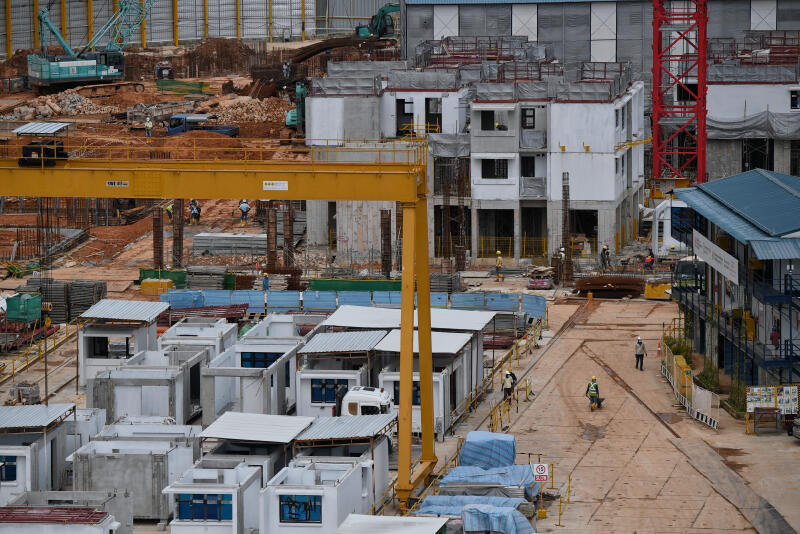Budget debate: New scheme to spur alliances aims to boost transformation of Singapore's built environment sector
Sign up now: Get ST's newsletters delivered to your inbox

The Growth and Transformation Scheme supports strategic alliances among developers, builders, consultants and sub-contractors.
ST PHOTO: KUA CHEE SIONG
Follow topic:
SINGAPORE - The push to accelerate transformation and boost the resilience of Singapore's built environment sector will intensify through a new scheme that supports strategic alliances among developers, builders, consultants and sub-contractors, Minister for National Development Desmond Lee told Parliament on Thursday (March 4).
Under the Growth and Transformation Scheme, each alliance will develop a business plan of at least three years that should clearly show how technology will be used to increase productivity, said Mr Lee.
It should also seek to achieve sustainability targets, build better capabilities, develop the workforce, and improve business growth and strategic collaboration.
"The alliance members will be collectively responsible for the outcomes committed to in their business plan. In this way, the value chain approach will help alliance members forge long-term collaboration, reap mutual benefits, and build capabilities through knowledge sharing and transfer," he said.
The built environment refers to man-made structures, features and facilities viewed collectively as an environment in which people live and work. The sector comprises industries such as security, construction, environmental services, real estate and smart facilities management.
Mr Lee noted that there are "heavy inter-dependencies" among the different stakeholders along the value chain in the built environment sector.
"Developers work with builders and consultants on each project, who in turn rely on multiple tiers of contractors and sub-contractors for different aspects of the project.
"Given these interlinkages, it is difficult for any one firm in the value chain to transform on its own. And this pandemic has shown that we are only as strong as the weakest link in the chain," he said.
The value-chain approach of the Growth and Transformation Scheme differs from existing schemes in two ways, explained Mr Lee.
First, unlike existing schemes that support individual firms, the scheme supports alliances of firms across the value chain, with the view of uplifting the entire built environment ecosystem.
Second, existing schemes focus on individual projects, which can result in contractors operating at very thin margins to meet short-term targets without the capacity to invest in long-term transformation. In contrast, the GTS supports firms in improving their capabilities, not just in completing specific projects.
The scheme will thus also help to pave the way for the alliances to take on larger or more complex projects, or develop niche strengths in the future, he added.
Mr Lee said the scheme will be rolled out with a few alliances first. "Over time, the GTS can catalyse transformation throughout the ecosystem, so that the sector can progress together. With enhanced capabilities and a stronger track record, Singapore firms will also be better placed to compete in construction tenders both here and abroad," he said.
In addition, other broad-based incentives to help firms accelerate their transformation, such as through the construction productivity and capability fund, will be enhanced.
Referring to how the industry was hit very hard by the pandemic, he said: "This experience has strengthened our resolve to accelerate the pace of change as set out in our Industry Transformation Map, and decisively transform the way we design, build and maintain our city. We cannot go back to how we used to do construction before."
In response to points raised by Ms Poh Li San (Sembawang GRC) and Mr Xie Yao Quan (Jurong GRC), Mr Lee noted that even though construction has resumed, the industry still faces serious challenges. "Safe management measures on worksites have affected productivity, while restrictions on the inflow of foreign workers have resulted in a labour crunch and higher manpower costs."
But amid ongoing challenges, construction demand is expected to recover in the coming years. For 2021, between $23 billion and $28 billion worth of projects are expected to be awarded, up from $21 billion last year, Mr Lee said.
If needed, some planned public sector projects may be brought forward to help support the industry, he added.
The Government will also strengthen regulations to spur productivity growth and reduce the industry's reliance on foreign manpower, as well as step up research and development efforts to create innovative solutions for the sector.
Foreign manpower levers in the construction industry will also be reviewed, said Mr Lee.
"As announced at MND's COS in 2019, we intend to remove the man-year entitlement framework in the near future, and replace it with a system that incentivises more productive off-site work. We are also studying the reduction of the construction dependency ratio ceiling to support more manpower-lean construction," he said.
"We are aware that changes in these regulations will impact the construction industry. We will continue to consult our industry partners before making any major moves."
Further, the Government will enhance the buildability framework to raise productivity standards, and make design for manufacturing and assembly (DfMA) the default method for large projects.
Mr Lee noted that these moves may cause some pain in the short term. "But as we have learnt from Covid-19, these structural changes are necessary so that we can build greater resilience in our industry."

